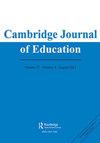学习和谐相处:一个概念框架
IF 1.5
3区 教育学
Q2 EDUCATION & EDUCATIONAL RESEARCH
引用次数: 0
摘要
摘要“学会共同生活”(LTLT)在SDG 4.7和Delors报告中得到了强调,后者认为它是四大教育支柱之一。LTLT经常被用作一个类似伞式的术语,导致难以为教学实践和政策提供信息。在印度,奥罗宾多、达赖喇嘛、甘地、克里希那穆提和泰戈尔提出了“心灵教育”等协同意识形态。他们创办了一些学校,其中一些是在一个多世纪前,致力于实现这些目标。本文利用教师对LTLT的认知,建立了LTLT的概念框架。该论文借鉴了一个更大的多嵌入案例研究,包括对上述哲学家创建的五所学校长达10个月的沉浸式研究,以及对14名教师和5名校长的民族志观察和采访。研究结果将LTLT重新定义为LTLT“和谐”(LTLTH),并构建了一个具有三个域的互连2D框架,这三个域与六个维度相交。本文章由计算机程序翻译,如有差异,请以英文原文为准。
Learning to Live Together Harmoniously: a conceptual framework
ABSTRACT ‘Learning To Live Together’ (LTLT) has been emphasised in SDG 4.7 and the Delors report, with the latter suggesting it to be one of the four education pillars. LTLT has frequently been used as an umbrella-like term leading to difficulties in informing teaching practices and policies. In India, Aurobindo, Dalai Lama, Gandhi, Krishnamurti and Tagore have proposed synergetic ideologies like ‘education of the heart’. They founded schools, some more than a century ago, which pursue these goals. This paper develops a conceptual framework for LTLT using teachers’ perceptions of LTLT. The paper draws upon a larger multiple embedded case study involving a 10-month-long immersion in the five schools founded by the aforementioned philosophers, as well as ethnographic observations and interviews with 14 teachers and five headteachers. The findings reconceptualise LTLT as LTLT ‘Harmoniously’ (LTLTH) and builds an interconnected 2D framework with three domains, which are intersected with six dimensions.
求助全文
通过发布文献求助,成功后即可免费获取论文全文。
去求助
来源期刊

Cambridge Journal of Education
EDUCATION & EDUCATIONAL RESEARCH-
CiteScore
5.30
自引率
4.30%
发文量
35
期刊介绍:
Cambridge Journal of Education publishes original refereed articles on all aspects of education, with a particular emphasis on work that contributes to a shared understanding amongst academic researchers, theorists, practising teachers, policy-makers and educational administrators. The journal also welcomes the submission of systematic review articles that summarise and offer new insights into specific areas of educational concern. With a wide international readership, Cambridge Journal of Education publishes contributions drawn from different educational systems and cultures enabling continued in-depth discussion of global educational theory, policy and practice. The journal’s Special Issue programme encourages and stimulates focused discussion and engagement with significant themes and responses to topics raised by readers and contributors. Cambridge Journal of Education welcomes proposals for future editions.
 求助内容:
求助内容: 应助结果提醒方式:
应助结果提醒方式:


